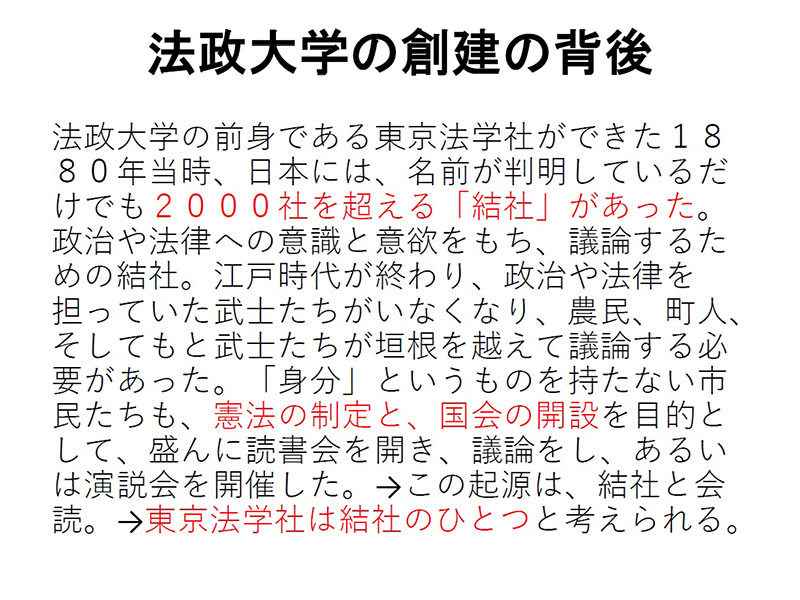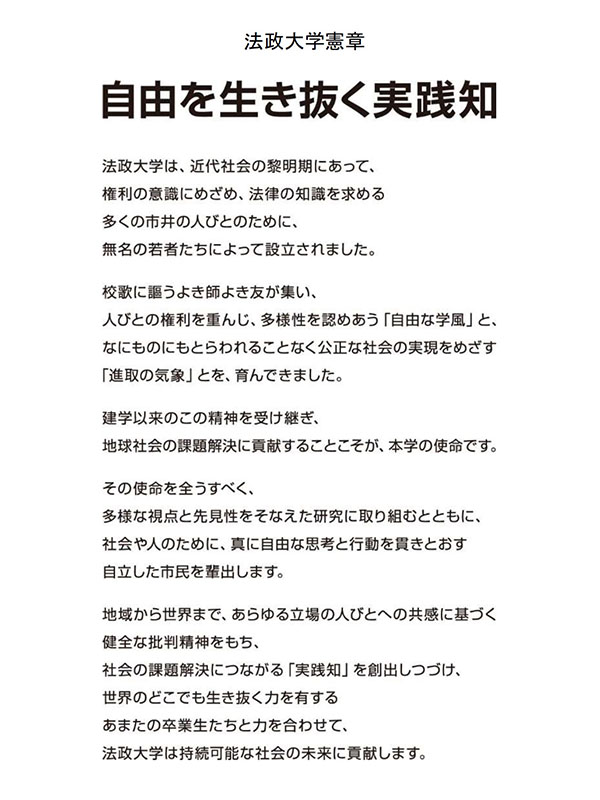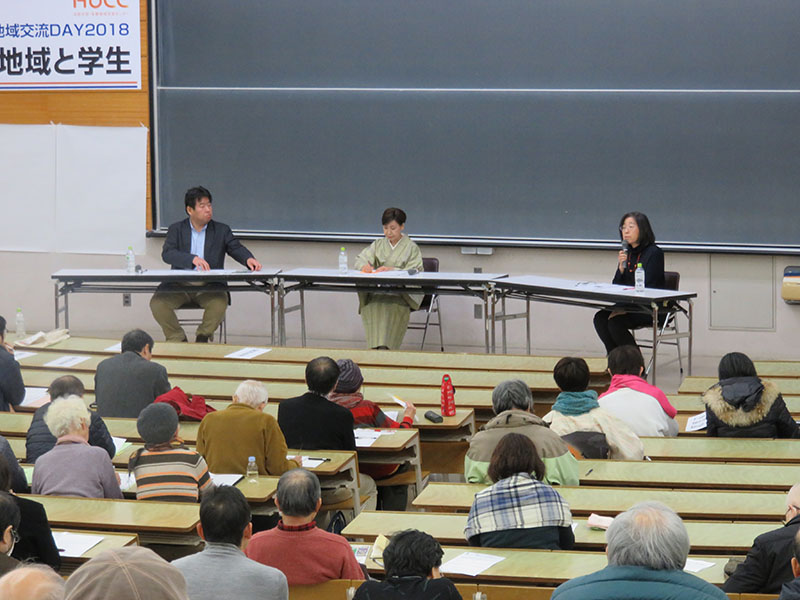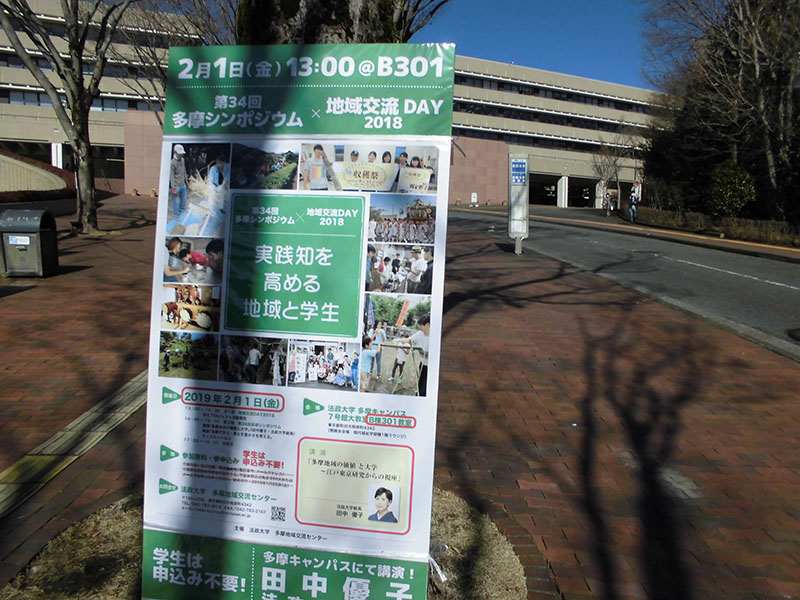Notices
The 34th Tama Symposium" Part 2: President Tanaka's Lecture and Trilogy 《Report》.
- Feb. 15, 2019
Hosei University's Tama Center for Social Innovation held the "34th Tama Symposium x Regional Exchange Day 2018 - - Enhancing Practical wisdom between the Region and Students" on Friday, February 1, 2018. The lecture "The Value of the Tama Region and the University: Perspectives from Edo Tokyo Studies" by President Yuko Tanaka and the aims of the first director of the Tama Center for Regional Exchange, Maki Hiratsuka, who was the director of the Office of the President at the time of the Center's establishment, provided an opportunity to reaffirm the significance of students and the region facing current regional issues together and the spirit of independence that the region surrounding the University has historically fostered. The event was a time to reconfirm the significance of students and the community working together to address current regional issues and the spirit of self-reliance that has historically been fostered in the area surrounding the university, and to reflect on "learning and living here. More than 200 people attended the event, including people from the active community, government, other universities, people involved in community development from around the region, and students. We would like to express our gratitude for their continuous support.
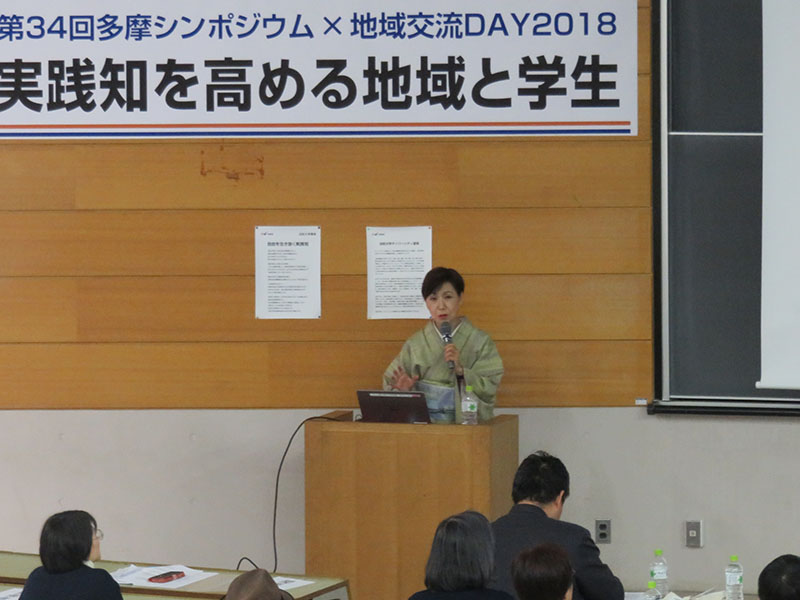
Part 2: "The 34th Tama Symposium
First half: Lecture by Yuko Tanaka, President Hosei University, "The Value of the Tama Region and Universities: Perspectives from Edo Tokyo Studies" (summary)
In ancient times, around the 5th to 6th century, skilled Koguryo people may have come to the Tama region. Various skills of people from the continent and the Korean peninsula who came from the west were established here. One is the culture of cloth. There was a spread of advanced technology centering on cloth. There was also a culture of pottery. The remains of Sue ware firing can still be seen on the north side of Aihara Station. It was a place with manufacturing technology.
In the Edo period (1603-1867), common people developed the technology and it became an industry. When Edo merchants came to buy, cash income came into the village. Because of their affluence and pride in themselves, when something happened, they countered with lawsuits, revolts, and rallies. This led to the later liberal civil rights movement.
With the influx of Edo culture, culture also flourished. The ceiling painting of Chofukuji Temple was made by Hasegawa Setsuzumi, son of Hasegawa Setsudan, who painted "Edo Meisho Zue" (Edo Meisho Zue). The Aoki family in Aihara was also a cultural elite, opening a Chinese studies school and practicing martial arts and haikai (haikai). In the field of Western medicine, four doctors in Aihara worked hard to spread smallpox to prevent smallpox.
Aihara had another unique feature not found in other areas. It was "irinchi," or common land where undergrowth was collected for livestock feed and fertilizer during the Edo period. When the cost of building an elementary school became an issue in the Meiji era, Aihara decided not to sell the land and built a school with donations from citizens. The school was built with donations from the citizens, and the timber from the land was used as the school's endowment property, which remained until 1966, when it was donated to Machida City. In the modern era, "private ownership of land" was the basic principle, and "common land" was never conceived of. However, when the "state" and the "public" were changing, the residents of Aihara did not just get involved, but devised ways of doing so. Hosei University's " Practical wisdom " is accompanied by "Surviving Freedom. Practical wisdom is to think about how to protect one's freedom while getting involved in various external situations. The admission area is an example of this.
There were a total of six terakoya and juku schools in Aihara. That is how many people wanted their children to be educated. In the Edo period, education taught people how to debate. The samurai of various clans had the ability to debate, which led to the Meiji Restoration and the liberal civil rights movement. In Tama as well, a number of associations of the civil rights movement were established one after another. Men and women of all ages gathered at a speech meeting in Aihara, and a newspaper wrote, "A cold village, but a place where speeches flourish. These movements did not begin suddenly in the modern era. It was a movement that took place in a region that had a history dating back to ancient times, where industry had developed on the back of technology, and where people had a sense of independence and solidarity, and where the modern government was saying all sorts of things.
It was 1880 when Tokyo Hogakusha, the predecessor of Hosei University, was established. It was the peak of the liberal civil rights movement. While various associations were being formed, the Tokyo Hogakusha was established as a legal association, and it became a university under the school system.
In the Tama region, it was important not to abandon the very high level of technology. The Tama area did not abandon its accumulated knowledge, which led to the market in the Edo period. Learning in Edo, new knowledge took root and went into the modern era.
Do not judge a place only by looking at this place today. Each land has its own history. The more rural the area, the more it has a very deep history. The further back you go, the more unique it is and the more prominent something is. By looking at the feet of a region, you can learn a lot about the history of Japan. I would like you to pay more attention and deepen your insight into Japan's footprints.
Second half: Trilogy "Considering the Richness of Learning and Living in Tama
Yuko Tanaka, President Tama President, Maki Hiratsuka, Director of the Office of the President (first Director of the Tama Center for Community Collaboration), Naoya Zuji, Director of the Tama Center for Community Collaboration
Intention of Establishing the Tama Center for Regional Exchange
Zuji: At the time of the center's launch, what were your visions for how the center would operate and how the Tama Campus would interact with the local community?
Hiratsuka: The trigger was the dining hall problem on campus in 2009. One of the cafeterias would repeatedly lose money even after changing vendors. I changed my mind and thought that this area might be rich in something different from market principles, so I followed the local network and asked if there were any people who would be interested in working together on the cafeteria project. When we held an information session, a great number of people came, and we realized that there were so many people in the community who were interested in doing something with the university. What we learned was that by focusing on the community, we could work together to solve the problems the university was facing. If that is the case, then we can work together with the local community to solve the problems they are facing, even if we do not solve them. Therefore, we decided to create a department on the Tama Campus that would serve as a contact point with the local community, and to create something from there. Professor Oyama (the second director of the center), a professor at Faculty of Social Policy and Administration who helped establish the center, suggested the phrase "the entire community campus," and we began to use that as our catchphrase. For the students, the campus is not the only place to learn; the whole community is the campus. The students learn, we learn, and the community learns as well.
Zuji: Wasn't it a hurdle to go into a place you had no contact with before?
Hiratsuka: I thought there would be conditions for the center to grow. There were four.
One was to create a system in which not only faculty and staff members would coordinate, but also students would become staff members.
The second was to create several posts of coordinators for regional cooperation. When connecting the university and the community, especially when students go out into the community and the university connects with the community, the relationship of trust tends to break down unless the community is nurturing and receptive. We discussed the importance of coordinators in building such a relationship of trust between students and the community, and that they should be firmly positioned as coordinators, not faculty or staff members.
The other was the creation of a "grant" mechanism. The idea was to open up as many opportunities as possible by creating a grant system so that the financial burden would not be a barrier to activities in the community.
Finally, we wanted to find good encounters with people in the community who would nurture the students. We thought that such people in the community who would take a long view, sometimes harshly, sometimes warmly, were important conditions for us.
I was surprised and struck by the process over the past several years of coming from a place with no substance and evolving through the combination of such things to create this kind of place.
Tanaka: There must be things that can only be done at the Tama campus in Tama, and I think the exchange center is playing one of these roles. As a faculty member at Tama, I feel that students tend to do various things on their own, including seminar activities and classes, but they also tend to create things on their own. I think the central point of the Tama Campus is that students graduate with the ability to develop such skills because of the Tama Campus.
Students are replaced...
Zuji: I would like to consider a question from the audience. What do you think about the point that "students are replaced," which can be said to be the fate of universities?
Hiratsuka: I feel that people will be replaced but students will be connected. I am the advisor of "Tamabora" and I hear from people who have graduated and are watching over them somewhere. Even for those who have graduated, there is a part of them that has become their roots even after they have started working. I feel that the vertical connection among students is a powerful thing. It is not impossible for people to accidentally disappear and become disconnected, but if they have the experience of having been nurtured while they were students, it becomes a place they want to return to even after they graduate. In fact, I have heard that people sometimes come back and are frustrated to see the current students and feel that they have improved. People are replaced, but I think the students continue to come back.
Tanaka: It is strange, but universities have their own personalities. Students who graduate pass something on to the younger students who worked with them while they were still in school. They show their attitude, their way of life, and their values. In this sense, students are replaced, but I believe that there is a link between them. The experience of working as an ambiguous entity is strong when conveyed as the history of the Tama Campus. It is not just a matter of doing fieldwork, but being in the community on a daily basis is essentially very strong. If a mechanism can be created for students to live in the community, even if it is only for four years, I think it will become part of the history of the university as a relationship that will be passed down from generation to generation.
Zuji: When I was a graduate student, I was a member of a community development internship group that worked in a farming village. It has been going on for 20 years, although it is only students who are doing it. I think there is a kind of historicity or DNA that is passed down from generation to generation, as the President says. However, when there is a desire among the students to continue and a seed of a desire among the local community to do something about it, then the project will continue to be connected. I think it would be good if the Center could serve as a receptacle.
Yasunori Imaizumi (Hachioji Health Co-op): My name is Imaizumi. My name is Yasunori Imaizumi, and I used to work at Tatekaoka Danchi. The residents work together with the students. Some of the activities will cease when the students graduate, but the residents remember how much they enjoyed the activities. After the students have done something with young and flexible ideas, if the local community thinks it is a great idea, they should take over the activity. Since there is no seniority system, the community could take over what the students have done and pass it on to the students again. I don't think we should be afraid of losing students.
Zuji: The students may worry about it, but the people in the community have been there for a long time, so I think they can be connected to the students there.
On student growth and learning
Fig. 3: There was a question from the audience, but we do not measure the degree of improvement in ability before and after participation in activities. I don't think it is something to be evaluated. I think that such a thing will be clearly seen when they leave the company as a member of society. Is there any difference in the upbringing of students who study in undergraduate seminars and those who participate in activities at the Center?
Hiratsuka: I sometimes hear from students who are active in the Center that they are in a dilemma when it comes to job hunting, because they want to continue their activities, but they are afraid they will be left behind by others. I say from experience that students who are doing such things will be fine. If they have eyes to see, they will see how much good experience they had in college, how much they struggled and worried with others, and how much they grew up. I liked that in the first half of the report, they told me that they have issues and worries about their activities. Activity is always just a process. I believe that students who spend time in a process where one story calls for the next story can stand on their own without having to practice or study extemporaneously for that purpose, even in employment situations.
Zuji: President Tanaka, what do you think in terms of the richness of learning in Tama?
Tanaka: Each place has its own social issues. The Tama region has its own issues. In addition, there is the serious issue of an aging society with a declining birthrate, which is becoming a huge challenge for our society, and it is important to share this with others. It is important to share these issues with the people of the region, and by being in close contact with the people there, listening to their voices, and thinking about them, we will be able to see the issues facing Japan as a whole. Eventually, we will be able to look at the world as a whole. It does not mean that we are content to live in this small world, but through this we will be able to have a broader perspective and the ability to think. This is the kind of challenge that we will have to face with each other.
Another thing is that new jobs may emerge centering on the university, taking advantage of the characteristics of the region. Universities themselves should start their own businesses, taking the initiative and doing something together with companies. This is a new way of doing things that will emerge in the future. Not only research, but research will be linked to industry. This was the case in the Tama region in the past. Technology has been connected to the market since ancient times. I think it would be good to think about creating such an area together with universities.
How to utilize the perspective of learning from past history when facing challenges for the future
Zuji: I think the message of the President lecture was to learn from history and to learn from our own feet. When we face current issues and think creatively and innovatively about solutions for the future, how can we look toward the future?
Hiratsuka: In Aihara, where Dr. Tanaka spoke, he mentioned that it was a land that had survived freedom. He said that there was a technological and industrial base, culture, medicine, and schools, and that the people who lived there stood up when they encountered the absurdities of the world and sought their own community and order, and tried to protect their free and autonomous space while being torn apart by the larger society. I took it as such. The history of Aihara overlaps with what the Hosei University Hosei University Charter " Practical Wisdom for Freedom " aims to achieve, and I realized the significance of Hosei being located here. I thought that Hosei would be strengthened by letting the goodness of this land bloom and by strengthening the spirit of independence and spirit of the land embedded in the history of the area.
We have a class called "Tama Region Formation Theory" in which we learn about the region from various angles, but I thought it would be better to have a part where we learn more about the region and to create such a class with local people.
Zuji: "Being here" is something I am also concerned about now. In depopulated areas in farming and mountain villages, when the traditions handed down from generation to generation fade away, or when people are able to move, they lose a sense of meaning in being here and want to go elsewhere. The audience also commented on the lack of a sense of crisis among the residents. I would like to reaffirm the "meaning of being here.
Tanaka: History is a story. It is meaningless just to lay out references and evidence. In the end, there is a sense of value in the way the story is told. When people receive and tell these stories, they create a local narrative. That is history, and although I will only be here for four years, I hope you will pass it on to your students. I hope that the students will take these stories as their own. Last year, there was a trilogy discussion at the Edo Tokyo Research Center, and the theme was "avatars. It was about how many people live inside one person, and how we should cherish and utilize that. Having various stories within ourselves is the gateway to empathy with others. You can use that when you meet people from all walks of life. I think it is important for human beings to acquire "land as a story.
Zuji: One last word.
Hiratsuka: I am grateful to have had such a rich time with you today. I mentioned earlier that it is a process, but I think there will be new stories and evolution little by little next year and the year after that. I hope you will continue to be with us. I hope the students will continue their activities as well.
Tanaka: Thank you very much, community members. Various university campuses are returning to the city center, and Hosei will be here for a long time, although there will be many developments and many changes. The Edo Tokyo Research Center is also interested in holding events in Tama. I am sure that we can develop various events such as symposiums like this one and others that are more research-oriented, so please continue to support us.
Zuji: I think that having the President this time has allowed us to think from a broader perspective and on a longer time horizon.
It seems that other universities don't have the opportunity to connect people in the community with the Center as a hub. I would like to support the Tama Campus so that we can communicate the unique characteristics of the Tama Campus that we have created together with everyone. Thank you very much for your time.


